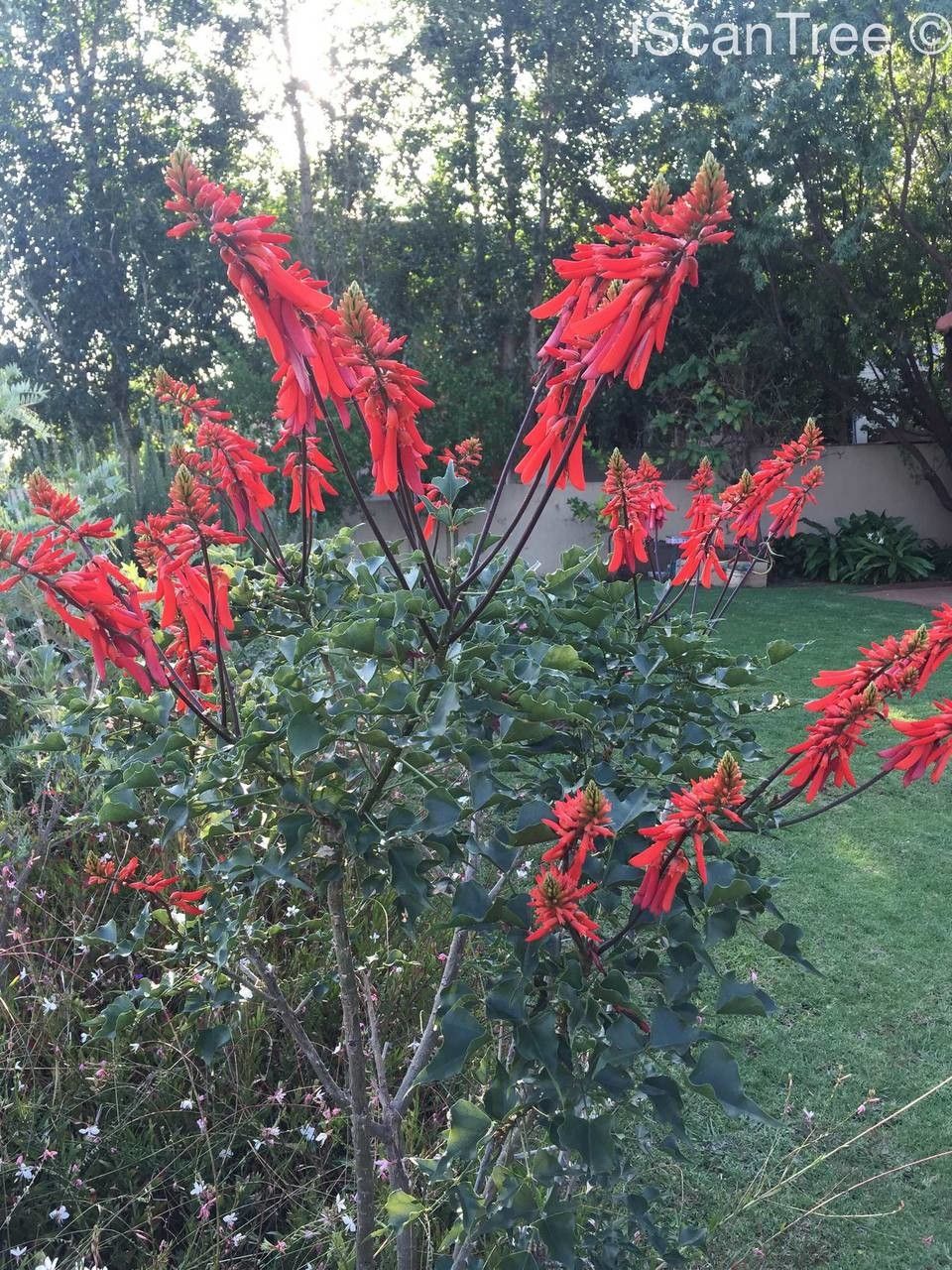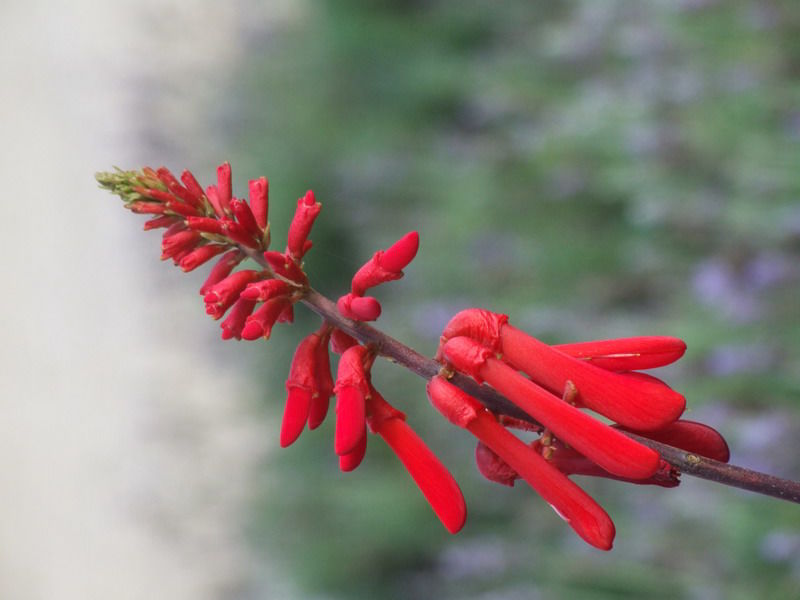Dwarf Coral Tree
erythrina humeana
Also known as: ["Dwarf Coral Tree","Umbrella Thorn"]
Overview
A deciduous tree native to South Africa, known for its vibrant red flowers and spiny stems.
Benefits & Perks
["long-flowering","wildlife attractant (bees, butterflies, birds)","drought tolerant"]
Botanical Classification
| Phylum: | Magnoliophyta |
| Class: | Magnoliopsida |
| Order: | Fabales |
| Family: | Fabaceae |
| Genus: | Erythrina |
| Botanical Name: | Erythrina humeana |
Plant Characteristics
Basic Information
- Category: Trees
- Suitable Location: outdoor garden in a sunny spot, protected from strong winds
- Suitable For:
- Is Weed: No
- Allergenicity: low
Environmental Needs
- Climate: {"temperatureRange":"5–35°C"}
- Hardiness: {"zones":"9–11"}
- Misting: rarely required, only if ambient humidity is very low
- Drainage: Fast-draining to prevent waterlogging.
- Soil Type: Well-draining, loamy soil with added organic matter.
Maintenance Level
- Maintenance Level: moderate
- Toughness Level: high
- Pruning Frequency: Annually in late winter or early spring before new growth begins.
- Pruning Intensity: Moderate; remove up to one-third of old growth to rejuvenate.
Care Details
Ideal Sunlight Coverage:
Full sun to partial shade; 6–8 hours of direct sunlight daily; adjust for intense summer sun.
Sunlight Tolerance Tips:
Acclimate gradually to intense sunlight; protect from harsh midday sun; provide dappled shade in extreme heat.
Care Requirements
Care Difficulty
moderatemoderate
Sunlight
full sun to partial shade
Rotate plant for even light exposure; use shade cloth in intense sun; avoid sudden light changes.
Watering
every 7–10 days during active growth, reduce in winter
Water thoroughly but infrequently; ensure soil dries between waterings; avoid overwatering, especially in winter.
Soil
well-drained, loamy soil with some organic matter
pH: Slightly acidic to neutral (pH 6.0–7.0).
Use a mix of potting soil and perlite; avoid heavy clay soils; ensure pots have drainage holes.
Temperature
Prefers warm temperatures (65–85°F); tolerates mild frosts but thrives in heat.
Avoid sudden temperature swings; protect from frost; ensure good air circulation.
Fertilizing
every 4–6 weeks during spring and summer
Dilute fertilizer to half strength; avoid fertilizing dry soil; flush soil occasionally to prevent buildup.
Propagation
Methods
Stem cuttings or seed; stem cuttings are more common for home growers.
Step-by-Step Propagation Guide
- Take 4–6 inch cuttings.
- Remove lower leaves.
- Dip in hormone.
- Plant in medium.
- Keep moist.
Best Time: Spring or early summer when plant is actively growing.
Environment
Warm (70–75°F), humid environment with indirect light.
Medium
Well-draining mix of perlite and peat moss or cactus mix.
Hormone
Recommended to use rooting hormone for faster root development.
Timeline
Roots develop in 4–8 weeks; new growth appears in 2–3 months.
Tools Needed
Pruning shears, rooting hormone, small pots, misting spray bottle.
Quick Tips
Use healthy, non-flowering stems; maintain high humidity; avoid direct sun.
Pruning & Repotting
Pruning Guide
Method
Selective thinning; cut just above a leaf node or bud.
Pruning Plan
Prune to maintain shape, encourage bushiness, and remove dead/diseased growth.
Tools
Pruning shears, loppers (for larger branches), sterilizing solution.
Checklist
Sterilize tools; prune dead/diseased wood; shape plant; clean up debris.
Repotting Guide
Best Season
Early spring before active growth starts.
Pot Size
Move to a pot one size larger (2–3 inches wider in diameter).
Method
Remove plant gently; trim roots if needed; use fresh well-draining soil; ensure drainage holes are clear.
Suggestions
Repot every 2–3 years or when roots fill the pot; needed for vigorous growth.
Checklist
Check root bound status; prepare new pot; use fresh soil; water after repotting.
Advanced Care Tips
Watering Mastery
Watering Checklist
Check soil moisture; water deeply; ensure drainage; adjust for season.
How to Apply Water Properly
Water at the base of the plant, ensuring moisture reaches the root zone; allow excess water to drain away; water in the morning to reduce evaporation and fungal risk.
Watering Schedule Tips
Water deeply once the top inch of soil is dry; reduce frequency in winter to prevent root rot.
Soil Improvement
Add perlite or sand for drainage; incorporate compost for fertility; ensure good aeration.
Temperature Stress Management
Signs of Temperature Issues
Yellowing leaves (cold stress); leaf drop (heat stress); stunted growth.
Cold Stress
Slows growth; may cause leaf drop; vulnerable to frost damage in freezing temperatures.
Solution: Protect from frost; move indoors in cold climates; use frost cloth for outdoor plants.
Hot Stress
Wilting; leaf scorch; reduced flowering; may drop leaves to conserve water.
Solution: Provide shade during peak heat; increase watering; mist foliage in extreme heat.
Fertilizing Guide
Fertilizing Checklist
Check season; dilute fertilizer; water before feeding; avoid contact with roots.
Fertilizing Method
Use balanced liquid fertilizer every 4–6 weeks during growing season (spring/summer); reduce or stop in fall/winter.
Common Problems & Solutions
Toxicity Warning
Cats
ToxicCats are highly sensitive to the toxic alkaloids present in Erythrina humeana. Ingestion can lead to severe neurological and cardiovascular effects, potentially resulting in fatal outcomes.
⚠️ Symptoms:
🌿 Toxic Parts:
⚡ Toxic If:
if eaten
Dogs
ToxicThe toxic alkaloids in Erythrina humeana can cause severe poisoning in dogs, affecting their nervous and cardiovascular systems. The toxins disrupt normal muscle function and can lead to life-threatening conditions.
⚠️ Symptoms:
🌿 Toxic Parts:
⚡ Toxic If:
if eaten
Humans
ToxicErythrina humeana contains toxic alkaloids that can cause significant physiological effects when ingested. The toxins interfere with neuromuscular transmission and can lead to severe neurological and cardiovascular disturbances.
⚠️ Symptoms:
🌿 Toxic Parts:
⚡ Toxic If:
if eaten
Frequently Asked Questions
Q: Is Erythrina humeana toxic to pets?
A: Yes, it is toxic to dogs and cats.
Q: Does this plant attract wildlife?
A: Yes, it attracts bees, butterflies, and birds.
Q: How drought-tolerant is this plant?
A: It is highly drought-tolerant once established.
Quick Reference
| Family: | Fabaceae |
| Care: | moderate |
| Light: | full sun to partial shade |
| Water: | every 7–10 days during activ |
Get Expert Care Tips
Download the Plantious app for personalized care reminders and plant identification!
Google Play App Store








